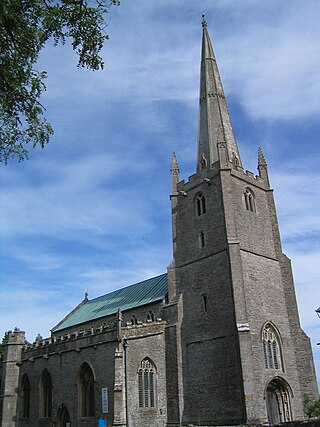
Congresbury is a village and civil parish on the northwestern slopes of the Mendip Hills in North Somerset, England, which in 2011 had a population of 3,497. It lies on the A370 between Junction 21 of the M5 and Bristol Airport, 13 miles (21 km) south of Bristol city centre, and 7 miles (11 km) east of Weston-super-Mare. The Congresbury Yeo river flows through the village. The parish includes the hamlet of Brinsea.

Badgworth is a village and civil parish in Somerset, England, 2 miles (3.2 km) south west of Axbridge. According to the 2011 census it had a population of 525.

St Andrew's Church is a Church of England parish church located in the village of Mells in the English county of Somerset. The church is a grade I listed building.

Ilketshall St Andrew is a village and civil parish in the north of the English county of Suffolk. It is 3 miles (4.8 km) south-east of Bungay and the same distance south-west of Beccles in the East Suffolk district. St Andrew's church is one of around 40 round-tower churches in Suffolk.

Temple Church, also known as Holy Cross Church, is a ruined church in Redcliffe, Bristol, England. It is on the site of a previous, round church of the Knights Templar, which they built on land granted to them in the second quarter of the 12th century by Robert of Gloucester. In 1313 the Knights Hospitaller acquired the church, following the suppression of the Templars. By the early 14th century, the church served as the parish church for the area known as Temple Fee. From around the same time, the rebuilding of the church on a rectangular plan started. This was completed by 1460, with the construction of a leaning west tower. The Hospitallers would lose ownership of the church in 1540 during the Dissolution of the Monasteries.

St Andrew's Church is the Church of England parish church of Burnham-on-Sea in the English county of Somerset. Of medieval origins, the church is a grade I listed building, well known for its leaning tower.

Saint Congar was a Welsh abbot and supposed bishop in Somerset, then in the British kingdom of Somerset, now in England.

The Anglican St Andrew's Church is on the outskirts of Chew Stoke, within the English county of Somerset. The church, parts of which date from the 15th century, is a Grade II* listed building.

The Church of St Cuthbert is an Anglican parish church in Wells, Somerset, England, dating from the 13th century. It is often mistaken for the cathedral. It has a fine Somerset stone tower and a superb carved roof. It is a Grade I listed building.

The Church of The Holy Saviour in Puxton, Somerset, England, dates from the 13th century. It is recorded in the National Heritage List for England as a designated Grade I listed building, and is a redundant church in the care of the Churches Conservation Trust. It was vested in the Trust on 1 August 2002.

The Church of St Mary in central Yatton, Somerset, England, is often called the Cathedral of the Moors due to its size and grandeur in relation to the village. It has been designated by English Heritage as a Grade I listed building.

The Vicarage in Congresbury, Somerset, England, includes an early 19th-century vicarage and former Priests House from around 1446. It has been designated as a Grade I listed building.

The Church of St Andrew in Old Cleeve, Somerset, England dates from the 12th century and has been designated by English Heritage as a Grade I listed building.

The Church of St Andrew in Stogursey, Somerset, England dates from the early 12th century and has been designated as a Grade I listed building.

The Church of St Andrew & St Mary in Pitminster, Somerset, England was built around 1300 and has been designated as a Grade I listed building.

The Church of St Andrew in Whitestaunton, Somerset, England, dates from the 13th century and has been designated as a Grade I listed building.

The Church of St Andrew in Curry Rivel, Somerset, England dates from the 13th century and is designated as a Grade I listed building. It was included in Simon Jenkins England's Thousand Best Churches.

The Church of St Andrew in Chew Magna, Somerset, England dates from the 12th century with a large 15th-century pinnacled sandstone tower, a Norman font and a rood screen that is the full width of the church. It is a Grade I listed building.

The Church of St Andrew is a Church of England parish church and civic church in the centre of Rugby, in Warwickshire, England. It is a grade II* listed building. It is unique in having two peals of bells hung in separate towers and is part of the Major Churches Network. The church has medieval origins, but was greatly enlarged during the Victorian era.

The Anglican Church of St Andrew in Dowlish Wake, Somerset, England, was built in the 14th century. It is a Grade II* listed building.




















